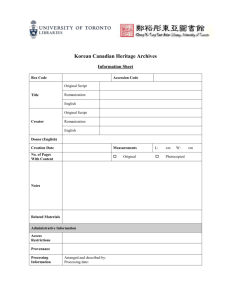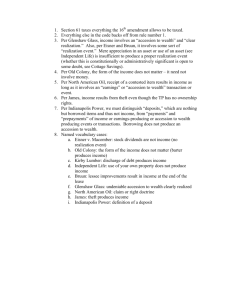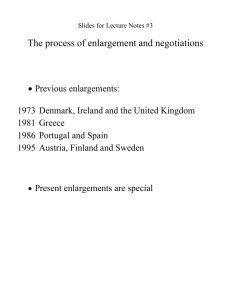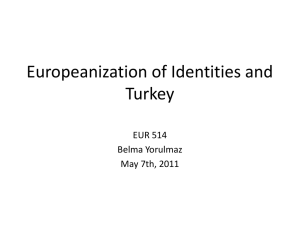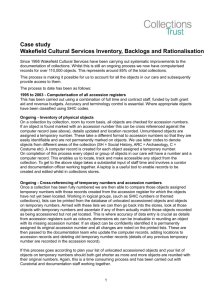Country-Level Evaluation of the 2004 EU Enlargement
advertisement
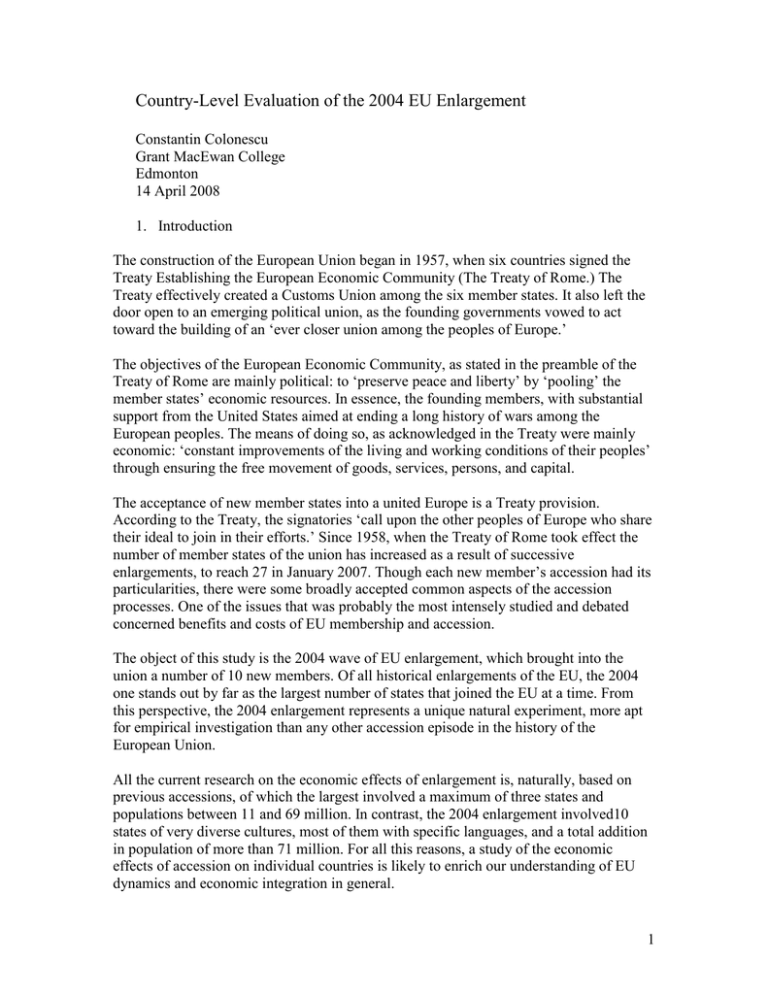
Country-Level Evaluation of the 2004 EU Enlargement Constantin Colonescu Grant MacEwan College Edmonton 14 April 2008 1. Introduction The construction of the European Union began in 1957, when six countries signed the Treaty Establishing the European Economic Community (The Treaty of Rome.) The Treaty effectively created a Customs Union among the six member states. It also left the door open to an emerging political union, as the founding governments vowed to act toward the building of an ‘ever closer union among the peoples of Europe.’ The objectives of the European Economic Community, as stated in the preamble of the Treaty of Rome are mainly political: to ‘preserve peace and liberty’ by ‘pooling’ the member states’ economic resources. In essence, the founding members, with substantial support from the United States aimed at ending a long history of wars among the European peoples. The means of doing so, as acknowledged in the Treaty were mainly economic: ‘constant improvements of the living and working conditions of their peoples’ through ensuring the free movement of goods, services, persons, and capital. The acceptance of new member states into a united Europe is a Treaty provision. According to the Treaty, the signatories ‘call upon the other peoples of Europe who share their ideal to join in their efforts.’ Since 1958, when the Treaty of Rome took effect the number of member states of the union has increased as a result of successive enlargements, to reach 27 in January 2007. Though each new member’s accession had its particularities, there were some broadly accepted common aspects of the accession processes. One of the issues that was probably the most intensely studied and debated concerned benefits and costs of EU membership and accession. The object of this study is the 2004 wave of EU enlargement, which brought into the union a number of 10 new members. Of all historical enlargements of the EU, the 2004 one stands out by far as the largest number of states that joined the EU at a time. From this perspective, the 2004 enlargement represents a unique natural experiment, more apt for empirical investigation than any other accession episode in the history of the European Union. All the current research on the economic effects of enlargement is, naturally, based on previous accessions, of which the largest involved a maximum of three states and populations between 11 and 69 million. In contrast, the 2004 enlargement involved10 states of very diverse cultures, most of them with specific languages, and a total addition in population of more than 71 million. For all this reasons, a study of the economic effects of accession on individual countries is likely to enrich our understanding of EU dynamics and economic integration in general. 1 Using a treatment evaluation method, this paper finds a significant positive influence of EU accession on the GDP per capita in most of the 2004 accession countries. A novelty of our method is to allow for individual (country) effects within the statistical model, while most of the previous works use simulations for case-specific inferences. We believe that most of the confusion in the literature on the effects of economic integration comes from the objective non-existence of a general result: whether economic integration is beneficial or detrimental to the new member state depends on the country’s circumstances. 2. Literature overview The literature on the effect of trade liberalization provides mixed results. For instance, Badinger (2005) finds no evidence of long term growth effects of economic integration, but some level effects. He uses a panel of fifteen EU member states over the period of 1950 to 2000, in a growth-accounting model. Other authors using various methods find either no effects, or significant effects (Landau, 1995, Henreckson et al, 1997, Vanhout, 1999, Brodzicki, 2005). Unlike most of the existing studies, the question we address concerns the effect of the official European accession of a large group of countries, the 2004 EU enlargement. We do not restrict our investigation to trade, but we include EU membership in all its aspects. 3. Method The empirical method used is treatment evaluation, which allows assessing the impact of an economic policy on selected economic variables (Heckman and Vytacil, 2005 give a comprehensive review of this method). Such economic variables could be gross domestic product, trade deficit, budget deficit, investment, inflation, economic growth, unemployment, and long term interest rates. The treatment evaluation method requires constructing a sample of countries that did not change their status during the sample period (the control group), and countries that became EU members during the sample period (the treatment group). Suppose the sample is comprised of a total of N countries. The simplest model that would serve the purpose of this study could be described by the following equation: Yit = αt + β Dit + vi + uit (1) In this equation, Yit, the dependent variable, stands for a measure of the macro economic performance or a development index for country i in year t; αt is a technical parameter that accounts for factors equally affecting all countries in year t; Dit is a dummy variable 2 equal to 1 if country i became an EU member in year t, and equal to zero otherwise; vi is a country-specific disturbance term that accounts for all unobserved factors influencing Yit irrespective of the observation year (country-specific fixed effects); uit is a standard stochastic error term that includes other unobserved factors that are uncorrelated with a country’s European membership; and finally, β is the parameter to be estimated. A value of β that is statistically different from zero would indicate that EU membership has a significant effect on a country’s economy. The sign of β shows whether the effect is positive or negative. This method is similar to Wooldridge, 2006:473; Vamvakidis, 1998 uses a similar fixed effects model to study the growth impact of broad, vs. regional economic liberalization. Panel data methods that are appropriate for estimating model (1) are based on two assumptions that are discussed next. First, the sample should be such that no country is included in the treatment group based on the expected effect of the treatment on the dependent variable. In other words, no country is offered EU membership for the reason that the country would benefit from that, and no country is denied membership based on the expectation that the country would be disadvantaged by being a member. It is reasonable to consider that this assumption holds in the case under study, because the Treaty of Rome bases EU accession on a country’s being European and pursuing the same democratic principles as the other member countries. Moreover, the Copenhagen criteria of accession do not relate membership eligibility to a particular level or growth rate of a country’s GDP. Second, it is assumed that each country in the treatment group is in all other ways similar to at least a country in the non-treatment group. Similarity is based on characteristics that are not explicitly included in the model, such as population, institutional supra-structure, etc. The sample under investigation includes in both groups small and large countries, and all are supposed to be functioning market economies with democratic political regimes. Economic applications of models of treatment evaluation have been criticized for failing to account for general equilibrium effects. In the EU membership context, a standard treatment model would assume that a country’s EU membership does not influence another country (see, for instance, Heckman et al, 1998.) Though the model presented here does not explicitly include general equilibrium effects, these are taken into account by measuring the outcome variable, the GDP per capita in terms relative to the EU27 average. To the extent that the new member countries affect the average GDP per capita in the EU, this effect must be incorporated in the data. Another justification for the validity of the method in this aggregate context is that the effect of the new members on the EU economy is so small that is hardly distinguishable. A variant of this model would capture the fact that the accession process is lengthy, spanning several years (introduce here a table with countries and how many years passed since the opening of negotiations and the actual accession.) One way to do this would be to introduce another dummy for the date the negotiations were open (or the accession contract was signed) with lags. Another issue is that it takes time for accession to affect 3 macroeconomic variables. Therefore, lags in the accession dummy may be useful. The new model could be, with the dependent variable in logs, logYit = αt + β1Dit + β2Dit-1 + β3Dit-2 + β4Dit-3 + vi+ uit (2) Here are the results of estimating (2) with the dependent variable being the log of GDP per capita in PPS as percentage of the EU27 GDP per capita. The sample consists of 33 countries over the period of 1995-2007. Twelve countries have become members of the EU in this period, but Romania and Bulgaria, which became members in 2007, are not included in the sample. (Stata output; Data Source: Eurostat.) . xtreg ly l(0/3).d, fe Fixed-effects (within) regression Group variable: i R-sq: within = 0.3741 between = 0.2326 overall = 0.0356 corr(u_i, Xb) Coef. d --. L1. L2. L3. _cons .08886 .1261728 .1652124 .1999385 4.475721 sigma_u sigma_e rho .52811004 .05726578 .98837843 F test that all u_i=0: 330 33 Obs per group: min = avg = max = 10 10.0 10 F(4,293) Prob > F = -0.2807 ly = = Number of obs Number of groups Std. Err. .01956 .01956 .01956 .01956 .0034562 t 4.54 6.45 8.45 10.22 1295.00 = = 43.78 0.0000 P>|t| [95% Conf. Interval] 0.000 0.000 0.000 0.000 0.000 .0503641 .0876769 .1267165 .1614426 4.468919 .1273558 .1646687 .2037083 .2384344 4.482523 (fraction of variance due to u_i) F(32, 293) = 777.20 Prob > F = 0.0000 The interpretation of the coefficient of the accession dummy, Coeff (D) = 0.09, is as follows. Integration increases a country’s GDP per capita by (Exp0.09−1)x100%, which is equal to 9.4%. In other words, if the country’s GDP per capita would have been 60 percent of the EU27 GDP per capita without accession, then accession increases this ratio by .094x60=5.64 percentage points in the year of integration. The coefficients of the lagged accession dummy variable are also positive, which indicates that the effect of accession extends over subsequent years. This process suggests that EU accession is a determinant of a country’s convergence towards the EU average GDP per capita. The method described so far is useful to determine if on average membership is likely to be favorable to a country. But we would like to now how individual countries reacted to EU accession. This can be done by introducing a set of country-specific variables, Cit, as follows: logYit = αt + β1Dit + β2Dit-1 + β3Dit-2 + β4Dit-3 + β5Cit Dit + vi + uit 4 With this change, the effect of EU accession in a country having characteristic Cit is the sum β1+β5Cit, which could be for some countries negative and for some positive. Ideally, the model should include all the factors that influence a country’s GDP per capita. Since such an attempt would unnecessarily complicate the model, we replace all those factors by the last period’s relative GDP per capita. Here are the results of a regression model where the country-specific variable is the rate of growth of Y in the year preceding EU accession, d(log(yi,t-1)). The new model is logYit = αt + β1Dit + β2Dit-1 + β3Dit-2 + β4Dit-3 + β5 ∆logyi,t-1 Dit + vi + uit . xtreg ly l(0/3).d ddly1, fe robust Fixed-effects (within) regression Group variable: i Number of obs Number of groups = = 329 33 R-sq: Obs per group: min = avg = max = 9 10.0 10 within = 0.3802 between = 0.2424 overall = 0.0386 corr(u_i, Xb) F(5,291) Prob > F = -0.2895 = = 19.42 0.0000 (Std. Err. adjusted for clustering on i) ly Coef. d --. L1. L2. L3. ddly1 _cons .0596547 .1261728 .1652124 .1999385 .8764243 4.479341 sigma_u sigma_e rho .52844829 .05718097 .98842709 Robust Std. Err. .0134101 .0227048 .032556 .0405725 .3240744 .0035478 t 4.45 5.56 5.07 4.93 2.70 1262.56 P>|t| [95% Conf. Interval] 0.000 0.000 0.000 0.000 0.007 0.000 .0332616 .0814863 .1011373 .1200858 .2385975 4.472358 .0860478 .1708593 .2292875 .2797912 1.514251 4.486324 (fraction of variance due to u_i) The coefficient of the contemporaneous accession dummy variable is now countryspecific and depends on a country’s rate of convergence in the period prior to accession: β1 + β5*∆logyi,t-1 The following table shows the marginal effects of integration for all ten countries. Since the dependent variable is in logs, the numbers in the table should be interpreted as percentages. For instance, for Cyprus the change in relative GDP per capita is equal to 5.57 percent. 5 . gen dydd=_b[d]+_b[ddly1]* dly1 (68 missing values generated) . list country dydd if d!=0, separator(0) country dydd cy cz ee hu lt lv mt pl si sk .0557288 .0948374 .1350384 .0862364 .1535799 .1030201 .0463918 .0704303 .0724963 .0708399 49. 62. 101. 179. 244. 270. 296. 335. 374. 387. The problem with this last model is that it contains a lagged dependent variable in the right-hand side, which induces serial correlation in the error term. We now estimate the model using a set of instruments for the lagged dependent variable. The instruments are lags of higher degree of the same variable. To account for the dynamic nature of the regression equation, we use a linear dynamic panel-data model (Arellano and Bond, 1991; Arellano and Bover, 1995; Blundel and Bond, 1998). . xtdpdsys ly l(0/3).d ddly1, lags(2) vce(robust) artests(2) System dynamic panel-data estimation Group variable: i Time variable: t Number of obs Number of groups Obs per group: Number of instruments = = = 329 33 min = avg = max = 9 9.969697 10 = = 19754.12 0.0000 Wald chi2(7) Prob > chi2 79 One-step results ly ly L1. L2. d --. L1. L2. L3. ddly1 _cons Coef. Robust Std. Err. z P>|z| [95% Conf. Interval] 1.17359 -.1985596 .0674504 .0641326 17.40 -3.10 0.000 0.002 1.04139 -.3242572 1.30579 -.0728621 .02523 .0348306 .0339556 .0277696 -.3576076 .1159669 .0111875 .0133439 .0111277 .0083777 .2121284 .0511494 2.26 2.61 3.05 3.31 -1.69 2.27 0.024 0.009 0.002 0.001 0.092 0.023 .0033028 .0086771 .0121458 .0113496 -.7733715 .0157159 .0471572 .0609841 .0557654 .0441896 .0581563 .216218 Instruments for differenced equation GMM-type: L(2/.).ly Standard: D.d LD.d L2D.d L3D.d D.ddly1 Instruments for level equation GMM-type: LD.ly Standard: _cons Now, these results seem to tell a different story. The accession coefficients remain positive, but their magnitudes are substantially lower than in the previous models. An Arellano-Bond test shows that there is no autocorrelation of higher order in this model: 6 . estat abond artests not computed for one-step system estimator with vce(gmm) Arellano-Bond test for zero autocorrelation in first-differenced errors Order 1 2 z -2.8221 .41512 Prob > z 0.0048 0.6781 H0: no autocorrelation If we re-calculate the marginal effects of integration for the accession countries, we find the following: . gen dydd=_b[d]+_b[ddly1]* dly1 (68 missing values generated) . list country dydd if d!=0, separator(0) 49. 62. 101. 179. 244. 270. 296. 335. 374. 387. country dydd cy cz ee hu lt lv mt pl si sk .0268319 .0108744 -.0055288 .0143839 -.0130943 .0075356 .0306417 .0208332 .0199903 .0206661 The table suggests that for two countries, Malta and Estonia EU accession might have slightly slowed down their convergence to the EU GDP per capita average. 4. Conclusion Our results are at this stage still to be refined. However, they suggest that European integration has had a significant effect on the new members’ economic performance in terms of convergence towards the EU average. The model used here allowed us to determine these effects on a country by country basis. 5. References Arellano, M., and S. Bond (1991) ‘Some tests of specification for panel data: Monte Carlo evidence and an application to employment equations,’ Review of Economic Studies, 58: 277-297. Arellano, M., and O. Bover (1995) ‘Another look at the instrumental variable estimation of error-components models,’ Journal of Econometrics 68: 29-51. Badinger, Harald (2005) ‘Growth Effects of Economic Integration,’ Review of World Economics 141(1): 50-78. Ben-David, Dan (2001) ‘Trade Liberalization and Income Convergence: A Comment,’ Journal of International Economics 55:229-234. 7 Blundell, R., and S. Bond (1998) ‘Initial conditions and moment restrictions in dynamic panel-data models,’ Journal of Econometrics 87: 115-143. Grabbe, Heather (2002) ‘European Union Conditionality and the Acquis Communautaire,’ International Political Science Review 23(3): 249-269. Heckman, James, Lance Lochner, and Christopher Taber (1998) ‘General Equilibrium Treatment Effects: A Study of Tuition Policy,’ American Economic Review 88(2): 381386. Landau, Daniel (1995) ‘The Contribution of the European Common Market to the Growth of Its Member Countries: An Empirical Test,’ Review of World Economics 131(4): 774-782. Slaughter, Matthew (2001) ‘Trade Liberalization and Per Capita Income Convergence: A Difference-in-Differences Analysis,’ Journal of International Economics 55:203-228. Vamvakidis, Athanasios (1998) ‘Regional trade agreements versus broad liberalization: Which path leads to faster growth? Time series evidence,’ International Monetary Fund Working Paper WP/98/40 Wooldridge, Jeffrey (2006) ‘Introductory Econometrics. A modern approach,’ third edition, Thompson South Western 8
